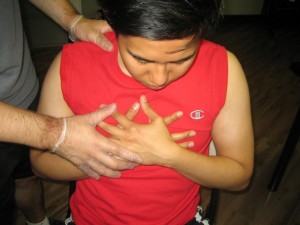Costochondritis or chest wall pain develops when then cartilage found between the rib and breastbone becomes inflamed and swollen. Costochondritis causes chest wall pain and tenderness since the affected cartilage is driven in the front of the rib cage. Women are more susceptible to this condition than men.
Causes of costochondritis
- Repeated trauma to the chest wall or viral respiratory infections
- Bacterial infections due to surgery in the upper chest
- Relapsing polychondritis, reactive arthritis and fibromyalgia
- Straining from coughing
Symptoms

- Tenderness when pressing the rib joints or costochondral junctions
- Chest pain triggered by certain activities, minor trauma or infection of the upper respiratory tract.
- Severe pain on the front chest wall that can radiate to the back or abdomen that result to back or abdominal pain.
- Pain is usually felt on the fourth, fifth and sixth ribs and pain becomes severe when moving the trunk or while breathing deeply.
Treatment
- Get enough rest to promote fast healing of the condition. Avoid performing unnecessary exercises or activities that can worsen the condition. Avoid contact sports until the affected area is totally healed.
- Slowly perform activities to steadily build up muscle strength and stamina. Be careful when performing activities that require sudden movements, high stress on the chest muscle or direct blows to the chest such as in baseball, golf, tennis, karate and basketball.
- Apply heat on the affected area for several minutes to promote proper flow of blood and relax tight muscles. Wrap a hot water bottle in a towel before placing on the area. Another alternative is using a heating blanket.
- Apply an ice pack on the affected joint to lessen the swelling and inflammation for at least 15-20 minutes. Repeat at least 3-4 times every day.
- Stretch the tight chest muscle around the joint such as performing yoga with deep breathing relaxes and stretching of the tight muscles. Another option is to perform pectoral muscle stretches. If any of these exercises cause pain, stop immediately to prevent the condition from worsening.
- When sleeping, look for a position that lessens the discomfort and avoid positions that places pressure on the painful joint.
- Maintain proper posture in sitting and standing to lessen the symptoms of costochondritis.
